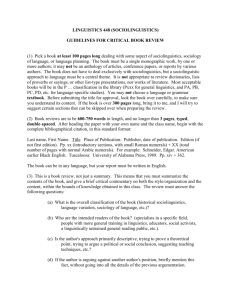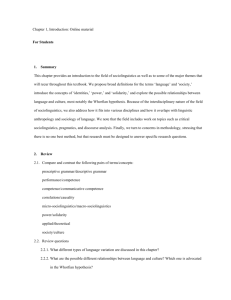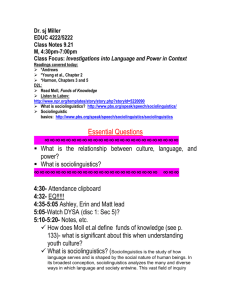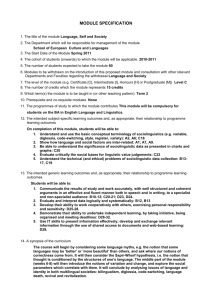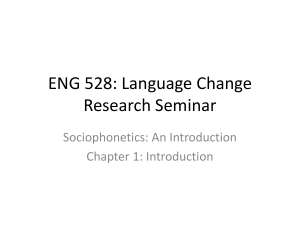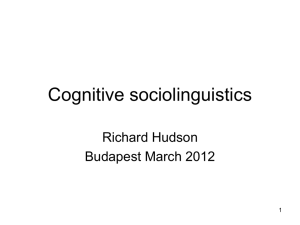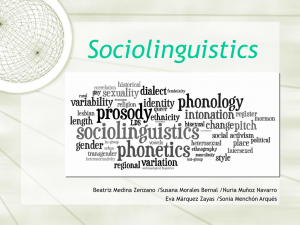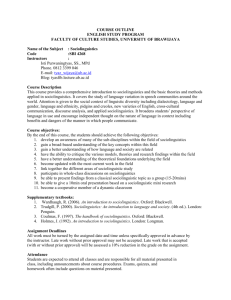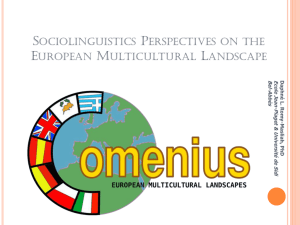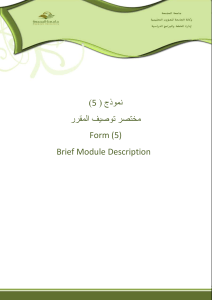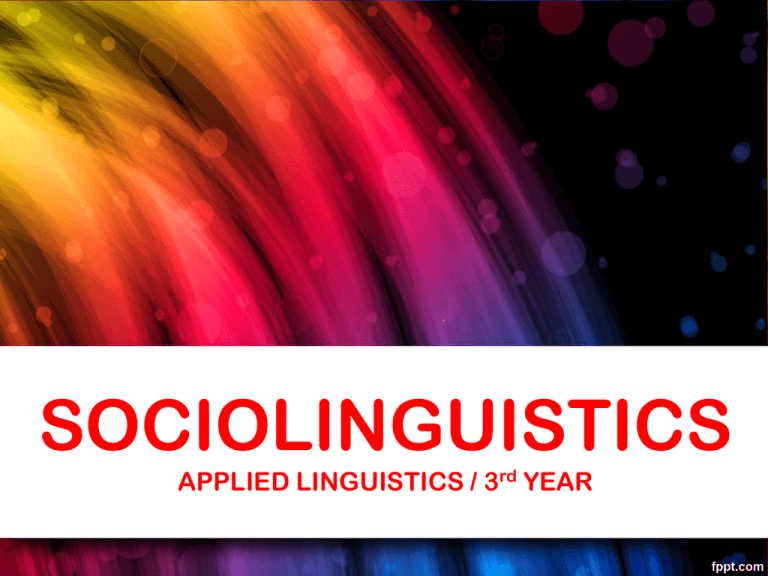
SOCIOLINGUISTICS
APPLIED LINGUISTICS / 3rd YEAR
1. WHAT IS SL?
“Time changes all things; there is no reason why language
should escape this universal law.”
Ferdinand de Saussure (1857-1913)
“Speech is not a personal possession but a social.”
Willian Dwight Whitney (1827-1894)
1. WHAT IS SL?
• It sounds too ‘academic’
• A clue: It must be related to society
• An Applied Linguistics branch dealing with the social
factors which affect the use of language
1. WHAT IS SL?
Language changes constantly at different levels and at
diverse places and times (Bright, 1998)
1. WHAT IS SL?
Language is a symbolic
indicator of behaviour = A
person's background, character,
and intentions are judged by the
use of language (“Linguistics
Program,” n.d.)
1. WHAT IS SL?
• SL channels the interest in the entwining
(connection) of language and society
• Two key concepts in SL:
― Variation: Language is likely to change
― Contact: Language changes spread through
contact (Eble, 2005)
1. WHAT IS SL?
Social factors bringing about change in language:
• Traditionally, class, ethnicity, age, and sex, together with
educational level, growing up learning or religious beliefs
= Attributes of the speaker
• But also, social attitudes, cultural differences,
discriminatory language or language policies
Particular to a certain group of people
=
1. WHAT IS SL?
• SL studies both general issues, e.g. How do religious
beliefs influence on language?, and more specific
topics, e.g. What are the traces of French in Cajun
Vernacular English?
2. THE ORIGINS OF SL
Sociolinguistics → developed over the last 50
years = a relatively modern discipline
Analysis of language and society in a systematic
way = clear relationship between the two
phenomena
Three progenitors → Anthropology, Linguistics
and Sociology (fields which somehow overlap) =
interdisciplinarity of SL
2. THE ORIGINS OF SL
Sociolinguistics → Fathers: William Labov (b. 1927) in the
US, and Basil Bernstein (b. 1924) in the UK
Other terms proposed → Sociolinguistics, Sociology of
Language and Linguistic Anthropology
SL first mentioned by English anthropologist Thomas Callan
Hodson in 1939 (“The origin,” 1979)
2. THE ORIGINS OF SL
Basic notion underlying SL→ Language as a social
instrument (more than words)
It represents social behaviour (“Linguistics
Program,” n.d.)
SL → A prominent discipline today
Two trends have characterized SL development:
– a large number of specialized areas
– results applied to social, educational and political problems
3. ISSUES SL DEALS WITH
Pass the salt!
Would you mind passing the salt?
I think this food could use a little salt
Mm, not a simple matter of sentence structure
This is Sociolinguistics
SL studies both general questions
and particular problems
3. ISSUES SL DEALS WITH
A. Gender-mixed vs. Non gender-mixed conversations
Varieties of speech associated with a particular gender
• Men use less minimal responses (mhm, yeah)
• Men use questions for information; women for different
purposes
• Men are more verbally aggressive in conversation
• Men’s language is less formal than women's
3. ISSUES SL DEALS WITH
B. Telling jokes
Individual variations: group, person, situation, gender,
age, educational level. (Kuypers, 2006)
Universal patterns: setting and characters
a Dutchman, a German and a Belgian
a man walks into a bar
a married couple
a dumb blonde
a woman at the doctor's
a fly in the soup
3. ISSUES SL DEALS WITH
C. Status of French and English in Canada
• Official languages since 1982
• Mother tongue: 60% English vs. 24% French
• Canadian English: British and American elements
• Canadian French: Status worse than European French + Many
Anglicisms: anyway, checker, cute, whatever, etc.
• Before: English as the language of prestige and business
• Now: Canadian French in both social and economic life
3. ISSUES SL DEALS WITH
•
•
•
•
D. Status of English in the United States
82% English / 12% Spanish
Several unsuccessful legislative proposals
American English + Canadian English = North American
English
Spanglish: bilingual speakers in the U.S.
Gloria: Open my gift!
Jay: Here we have a phone…in the shape of a mouth!
Gloria: You´re welcome! Very sexy!
Jay: Don´t tell me. I mentioned a few times that I would
like to have a saxophone and you give me this…I got it!
Is this a sexy-phone?
Gloria: Happy birthday!!!
(Taken from Modern Family)
4. BRANCHES OF SL
SL covers many sub-fields which are given several
different names. Among the most known ones there are
(Trudgill, 2003):
• Language Variation and Change
• Pidgin and Creole Languages
• Language Attitude Studies
4. BRANCHES OF SL
Language variation and change
Dialectology: The study of regional or social varieties of a
language
Social Dialectology: The study of a variety of speech
associated with a particular group within a society
Functional Variation (Register): The study of how
language is used differently by individuals for a specific
purpose or in a particular social context
4. BRANCHES OF SL
Pidgin and Creole Languages
(Or Language Contact Studies)
Nigeria English Pidgin
How bodi?
↓
How are you doing today?
Hawaian English Creole
Ai neva du om
↓
I did not do it
no structure
no fixed rules
its own grammar
invented by children
4. BRANCHES OF SL
Language Attitude Studies
Study of how people evaluate others based on the
language behaviour they observe
Two major approaches:
Behaviourist → attitudes are in people's responses
to social situations
Mentalist → attitudes as a reflection of an internal
state
4. BRANCHES OF SL
A question open to debate:
Does it make any sense to propose a classification on the
basis of the aspect of language affected, that is,
vocabulary, grammar and/or pronunciation?
4. BRANCHES OF SL
Example: Vocabulary change
Slang → words that are non standard in formal conversation
Jargon → words that are used in specialised environments
5. CONCLUSIONS
• An AL branch dealing with the social factors which affect the use of language
• Traditionally, class, ethnicity, age, and sex (Attributes of the speaker). But
also social attitudes, cultural differences, or language policies (Particular to a
group of people)
• A relatively modern discipline / The term was used for the first time in 1939
• Interdisciplinarity of SL steming from Anthropology, Linguistics and Sociology
• SL studies both general issues, e.g. How does humour work? and particular
problems, e.g. Which is the status of French in Canada?
• Many sub-fields within SL: Language variation and change + Pidgin and Creole
Languages + Language Attitude Studies, etc.
6. SOURCES
Part 1. What is SL?
Bright, W. (1998). Social factors in language change. In F. Coulmas (Ed.), The handbook of Sociolinguistics (pp. 82-91). Oxford: Blackwell Publishers.
Downes, W. (1998). Language and Society. (2nd ed.). Cambridge: CUP.
Eble, C. (2005). What is Sociolinguistics? Retrieved October 14, 2011, from http://www.pbs.org/speak/speech/sociolinguistics/sociolinguistics/#eble
Linguistics at NC State University. (n.d.). Retrieved October 11, 2011, from http://www.ncsu.edu/linguistics/aboutsociolinguistics.php
Part 2. The origins of SL
The origin of Sociolinguistics. (1979). In Language in society. Retrieved October 12, 2011 from
http://journals.cambridge.org/action/displayIssue?jid=LSY&tab=currentissue
Jaffe, A. (Ed.). (2009). Sociolinguistics perspectives. Oxford: OUP.
Meyerhoff, M. (2006). Introducing Sociolinguistics. Oxford: Routledge.
Part 3. Issues SL deals with
Bilous, F. R., & Krauss, R. M. (1988). Dominance and accomodation in the conversational behaviours of same- and mixed-gender dyads. Language &
Communication, 8, 3, 183-194.
Bond, K. (2001). French as a minority language in bilingual Canada. In Karen ‘s Linguistics Issues Web page. Retrieved October 26, 2011.
Kuyper, G. (2006). Good humour, bad taste: A sociology of the joke. Berlín: Walter de Gruyter.
Part 4. Branches of SL
Ammon, U., Dittmar, N., & Mattheier, K. J. (2004). International handbook of the science of language and society. (2nd ed.). Berlin: Walter de Gruyter.
Trudgill, P. (2003). A glossary of Sociolinguistics. Oxford: OUP.
http://www.hevanet.com/alexwest/pidgin.html
Sociolinguistics: An invitation*
They worked as a team:
• Beatriz Guillén Velasco
• María García Parra
• Mari Carmen García Sánchez
• José Jimeno Serrano
We hope you have enjoyed the presentation
Thanks for your attention

